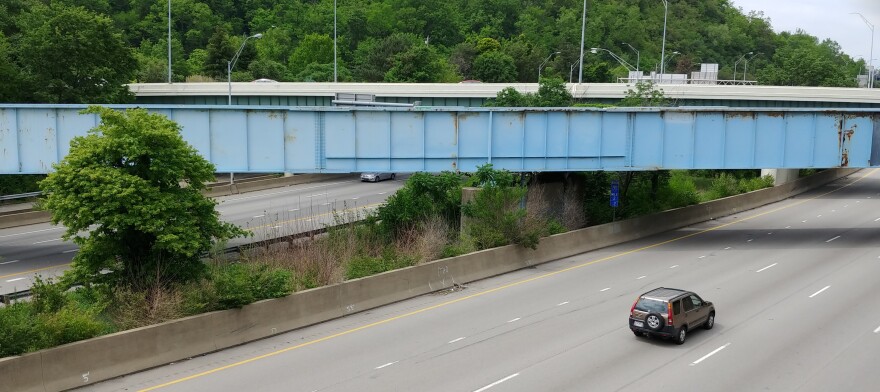OKI Wanna Know is a chance for you to get an answer about the area that isn't easily googled. This time, WVXU's Bill Rinehart looks into the past and the future of a Walnut Hills bridge that seemingly goes nowhere.
Updated: June 3, 2:10 p.m.
This question comes from Sandy Houck. She was walking with friends up to Mount Adams. When they got to the Cincinnati Art Museum parking lot, they looked down and saw a blue bridge, spanning I-71 between Reading and Gilbert. When they came back down, Houck says they tried to get on it, but were blocked by thick brush and fencing.
"Our conjecture was maybe it was an old trolley track thing, or old streetcar, or whatever mode of transportation they had back in the day, because it's really not wide enough for automobiles," Houck says.
She's not wrong. The bridge was built for a rail line that dates back to the 1880s. Roy Hord with the Cincinnati Railroad Club says what became the Cincinnati, Lebanon and Northern Railway had a station at Court Street, about where the Greyhound station is today. Trains ran north from there, through the suburbs to Dayton.

"The railroad was originally built to help develop some of those suburbs," he says. "It was funded by a lot of the people who owned property in those areas, and did a pretty good business running commuter trains from Montgomery and Norwood to Cincinnati."
Hord says it was the only railroad that came into Cincinnati that didn't follow a major waterway.
"They called that the Highland Route. Its location was such that whenever the city had a flood, which was about every five years, that was the only railroad that could be used to bring supplies into the city."
Passenger service on the CL&N ended when Union Terminal was built. That's where all passenger trains were routed starting in about 1933. Freight trains, however, kept rolling on the CL&N.
"There were a couple of warehouses that were right there by Elsinore Avenue," Hord says. "One of them was a warehouse for Hershey's products: candy bars and Hershey's syrup. I remember seeing them switch cars there and the cars were painted like giant Hershey bars."

The bridge in question wasn't built until the 1960s, when I-71 was constructed. Hord says it didn't get much use before it, and the whole line up the hill, were abandoned.
"The railroad grade was the same as the grade for the expressway. That's a pretty steep hill to get up to Avondale that way. It was a real struggle for the trains to get up there. Most of them had to be pushed up that hill until they got to the top. That was an operating headache for them."
Part of the CL&N rail line is in use around Norwood today. Hord says a couple of tunnels built for the trains are unused but still mostly intact along I-71. They're visible in the winter when the leaves have fallen, under McMillan and Oak streets.
"If you wanted to build a transit line from downtown Cincinnati to Avondale, all the hospitals, to Xavier, that'd be a perfect way to do it."
ODOT was looking at taking down the blue bridge in the early 1990s, but the city of Cincinnati stepped in with another idea. The City Planning Department suggested it might come in handy for a possible light rail transportation corridor along I-71. ODOT said you can have the bridge, if you take care of it. Cincinnati Council members approved the deal unanimously, and the city assumed control in 1994. Kelly Carr is an assistant to the city manager, and says there are no plans to tear it down in the foreseeable future.
Cincinnati Parks, in response to a tweet from @Kevin_D_Shaw, says they have plans for the bridge. It will be opened as a pedestrian bridge when the nearby Johnston Park is renovated. That will happen when Cincinnati Parks secures funding.
Yes, this bridge will eventually be repurposed to a pedestrian bridge when Johnston Park is renovated. Renovations won’t begin until we have secured funding for this project.
— Cincinnati Parks (@CincyParks) June 3, 2021
If you have a question and no one else can help, ask OKI I Wanna Know by filling out the form below.



